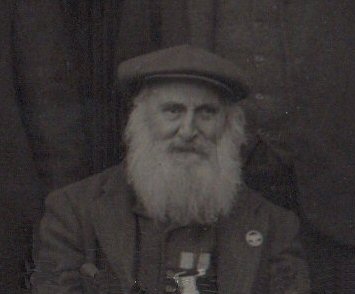 Thomas
Warr was born on 28th August 1830 at Grove buildings, Dorchester and
baptised at St George’s Fordington in February 1831, the son of William
and Jane Warr he had just one sister Mary, five years his elder. Tom
as he was known claimed to have been one of the first people admitted
to the Dorset County Hospital in 1848 suffering from the effects of a
gunpowder explosion, why or how he came into contact with gunpowder cannot
be ascertained but it is interesting to note his father’s occupation
was a master cooper and gunpowder as you know was stored in barrels so
it is quite possible the accident occurred whilst working with his father. <<<
Photograph: Thomas Warr taken in 1913
Thomas
Warr was born on 28th August 1830 at Grove buildings, Dorchester and
baptised at St George’s Fordington in February 1831, the son of William
and Jane Warr he had just one sister Mary, five years his elder. Tom
as he was known claimed to have been one of the first people admitted
to the Dorset County Hospital in 1848 suffering from the effects of a
gunpowder explosion, why or how he came into contact with gunpowder cannot
be ascertained but it is interesting to note his father’s occupation
was a master cooper and gunpowder as you know was stored in barrels so
it is quite possible the accident occurred whilst working with his father. <<<
Photograph: Thomas Warr taken in 1913
In August 1850 Tom was in London, why he was there we will
never know, if he was seeking employment he certainly succeeded, on the
6th August he dropped into the Hog’s Head in Westminster where he was spotted
by several recruiting sergeants. Tom was much impressed by the uniform
of sergeant of the 11th Hussars wearing crimson overalls and answered
he didn’t mind enlisting ‘but it must be the same regiment as that of the
man in the red trousers’ so he ‘swallowed’ the King’s shilling and joined
the regiment at Norwich. The regiment were at Portobello Barracks, Dublin
when the Crimean War broke out and embarked at Kingstown for Crimea.
He served with his regiment at the Alma and in several
other famous battles but the most memorable incident in Tom’s life was
his participation in the famous Charge of the Light Brigade on 25th October
1854. Tom describes the charge in a newspaper report many years later:-
“We just trotted some distance down the valley towards the Russian
position and could see their cavalry retiring behind the guns. The
artillery opened fire on us; yet on we rode; but not until within a
short distance of the guns did we break into a gallop. As we rode through
the guns, I cut down a gunner and, to my astonishment the poor fellow
had been chained to his gun.”
When the survivors rallied they had suffered severely from the Russian
infantry. Tom’s charger was badly wounded and he had to lead it back
to the rear where it had to be shot. He himself escaped unscathed although
bullets repeatedly skimmed near him. He was awarded the Crimea medal
with four clasps for the Alma, Balaclava, Inkerman and Sebastapol, he
also received the Turkish medal.
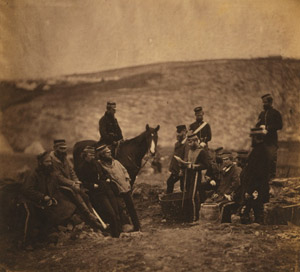
<<< Photograph of Officers of the 11th Hussars from the Fenton collection
Library of Congress, Prints & Photographs Division,
[LC-USZC4-9341]
Full rights and restrictions information is available at: http://www.loc.gov/rr/print/res/277_fent.html.
Tom remained in the Army for several years and in 1861 can be found in Hulme Barracks, Lancashire. He left the army in August 1862 and seems to have returned immediately to Dorchester as this is where he lost his medal in 1863, in his own words “ up the road when Fooks and Preedy were hung” (Link to newspaper articles - see Execution at Dorchester - 28 Mar 1863)
By 1871 Tom can be found working as a basket maker, a lodger in the Mason Arms his income would have provided for the necessities of life but not much else, life at times must have been quite grim but from what I have learned of Tom he would have always had a smile or a cheery word for people.
Early in 1881 Tom married Amelia Wareham a widow from Shroton [Iwerne Courtney]. The census of that year was taken only a few months later and we find Tom and Amelia living in Pease Lane in the parish of Holy Trinity along with Amelia’s daughter Kate. In 1882 Kate married John Rock and moved to Gillingham in Kent allowing Tom a few precious years with Amelia for their marriage was sadly a short one as she died in 1886 and is buried at the civil cemetery in Dorchester.
Tom continued his work as a basket maker and in 1891 is still living in the house he an Amelia shared; sometime between that date and the next census of 1901 Tom was admitted to the workhouse, for what reason it is difficult to tell, it could have been because of his age and infirmity but as he is listed as a basket maker and still employed it seems probable he had to leave his rented accommodation and couldn’t find anywhere else, whatever the circumstances Tom was well liked by the master George Brown who later referred to Tom as his old protégé.
Around 1911 Tom received a small supplement to his pension which allowed him to take lodgings the first of which was in Victoria Park, it was here in January 1913 that Tom received a duplicate of the medal he lost in 1863. The Dorset County Chronicle reported:-
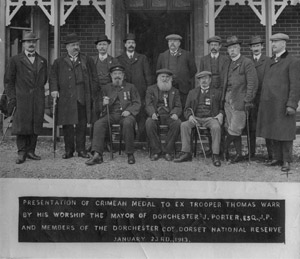
<<< The presentation of a duplicate medal to Tom, 1913
“Mr Thomas Warr was at home in both senses of the word. Indeed he had never in his life had so many callers at one time. He was discovered in that attitude so characteristic of the Englishman, standing with his back to the fire and with his well coloured clay in his mouth. After heart greetings had been exchanged Major Willcock explained the object of the visit. The Mayor said that he had a very pleasant duty to perform – to present to Mr Warr, on behalf of the subscribers present and absent, a new medal to replace the medal lost by him 50 years ago. He was glad to find Mr Warr looking so well and enjoying, considering his age, such good health.
Mr Porter then pinned upon the waistcoat of the veteran, the mint-new medal with its pale blue ribbon and yellow stripe crossed by four bars. Mr Warr expressed his intention to have the medal affixed to his Sunday waistcoat. He then signed a paper bequeathing the medal on his death to his old regiment, who would prize it as a regimental heirloom to be proud of. As he put down the pen ‘old Tom’ as he is affectionately called, observed quietly, the fact of the matter is, when I’m gone I don’t mind who do have ‘em.”
Full transcription of the newspaper article on the presentation from the Dorset County Chronicle
A few years later Tom moved to Dagmar Terrace and it was here in June 1916 at the age of 86 that he died. Tom’s old regiment honoured him by sending six senior NCO’s as bearers and the Trumpet-Major to sound the last post, considering the times and that the battle of the Somme occurred only two weeks later this was indeed an honour. The coffin draped in the Union flag was taken through the town, along the Great Western Road, up South Street and down High East Street to Fordington St George, the whole route being lined with people paying their respects. At the graveside after the Benediction the firing party discharged three volleys into the air, arms were presented and the cavalry trumpet played the last post over the grave of the old trooper.
Commemoration
Many years later in 2006, I visited a friend who gave me a photograph of the presentation asking me to find out more about Thomas Warr, all he knew about the photograph was that the gentleman on the far right had lodged with his grandmother who had been given the photograph on his death. On doing the usual investigations, census returns, parish records etc it started to become clear there was more to this man’s story. Using the date on the photograph I took a look at the microfilm of the Dorset County Chronicle at the Dorset History Centre and was amazed to find that Tom had been one of the few to survive the famous Charge of the Light Brigade. After some more articles were found and more investigations made, I posted some of the information to a forum online to see if anyone knew of Tom Warr or could give me further information on his military history. This led to an article in The War Correspondent, the journal of the Crimean War Research Society.
Meanwhile former soldier Peter Metcalfe of Dorchester had also become interested in the life of Thomas Warr. After visiting the Crimea he was amazed to find the soldier had lived in his town but was saddened to find Tom was buried in an unmarked grave. Peter then found my article in the War Correspondent but couldn't find how to contact me, eventually an article appeared in the local Echo which led to me contacting him.
Peter Metcalfe said to the Western Gazette:
“The funeral which took place ten days before the start of the Battle of the Somme, was a massive event for Dorchester and that it was a mystery as to why the grave was left unmarked. His regiment took pity on him and sent six non-commissioned officers to act as pallbearers and soldiers from the Dorset and Gloucester shire Regiment for the burial party. He was well known in Dorchester and the town gave him a full military Funeral, but because he had no money he was buried in an unmarked paupers grave. For a bloke to have done what he did only to be completely ignored by his country after this incredible event is woeful. It is only right and proper that we should do this for him now. We are doing it because of the role he played in British history. I hope he would be very chuffed with it.”
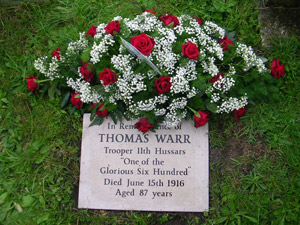
<<< The Plaque placed on Tom's grave in October 2006
A plaque was donated by funeral director Peter Gawler of Woods Funeral Services in Dorchester, Peter Gawler told the Western Gazette:
I thought about this old chap lying unmarked all these years. It just got to me. Trooper Warr had a dog’s life when he came back here.”
A service of remembrance was arranged by Peter Metcalfe and Paul Gawler and held on 25th October 2007 the 152nd anniversary of the Charge of the Light Brigade. The service at St Peter’s Dorchester was conducted by the Rev. Drucilla Dennis, with tributes read by myself and Peter Metcalfe and one of Rudyard Kipling’s less well known poems ‘The Last of the Light Brigade’ being read by Geoff Vennor.
After the service a black carriage pulled by two Belgian black horses, troopers dressed in authentic period uniforms and soldiers from the King’s Royal Hussars made their way down High East Street. A stone tablet made and donated by Paul Gawler was unveiled by the Mayor Robin Potter.
One sad aside to the story was that we were unable to find where Tom’s wife Amelia was buried, I mentioned this to Paul Gawler saying I thought perhaps she was buried in the Civil Cemetery, this is indeed where Paul found Amelia’s grave and like so many it was also unmarked; Paul Gawler has now made another tablet to mark Amelia’s grave and placed flowers on her grave too.
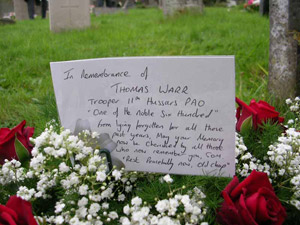 From Paul Gawler to 'Old Tom' |

Soldiers of the King's own Hussars in replica Uniforms |